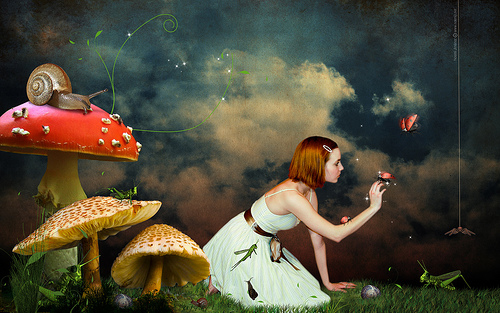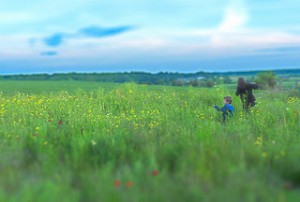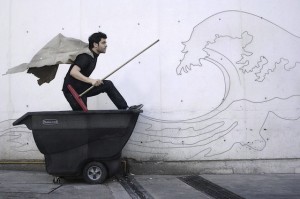 This post originally ran on June 26, 2012. Since then, the researchers have published some of the results of their work with imaginary worlds. I’ve included this (along with making a few other edits) below. My own experience of imaginary friends has also expanded, now that we have two new boys named Pumpernickel and Garbanzo living in our house, alongside all the real ones.
This post originally ran on June 26, 2012. Since then, the researchers have published some of the results of their work with imaginary worlds. I’ve included this (along with making a few other edits) below. My own experience of imaginary friends has also expanded, now that we have two new boys named Pumpernickel and Garbanzo living in our house, alongside all the real ones.
*
I remember the day the horses arrived. It had been raining, and for two kids cooped up inside, the afternoon seemed to stretch into years .
And then there were horses. Some were dark as thunderclouds, some roan, some palomino. There were wild mustangs and Icelandic horses with manes like clouds. My best friend and I picked each name—there was Stormlight, that one’s Mackintosh—as they came down the hall.
There was also one with a rainbow coat. Another had an eggplant-colored mane. A few could even fly.
As you might have guessed, these horses weren’t something anyone else could see. Only the two of us watched them canter along the nubby hallway carpet. We’d been kept inside, away from the empty lot behind my friend’s back fence, where we had a world called Orak. There, dwarves crouched in tree stumps and elves reached into their quivers for silver arrows. Now our world had come to us.
I’ve always thought worldplay like this was something modern—which seems ridiculous, now that I think about it, because why would people in the past have smaller boundaries on their imaginations? (And it’s not like I was terribly original, either, with most of my ideas coming from already-created lands like Narnia and Middle Earth, the World of Two Moons and Camelot).
People have been creating imaginary worlds for millennia. Aristotle wrote about the art of memory, and others in ancient Greece and Rome elaborated, discussing the creation of what became known as memory palaces, real or imagined places that can store information in the mind.
That’s what got Jacob Levernier, a doctoral student at the University of Oregon, interested in the imaginary worlds. He’d been studying psychology and medieval philosophy as an undergraduate and learned about memory palaces of the past. In the Middle Ages, monks used the architecture of their imaginations to store scripture and teachings. They also simulated experiences in their minds that would help them, for example, act in a more moral way in different situations, as well as instructing others in these practices.
The Reformation put a damper on memory palaces, but imaginary worlds continued to appear in literature and art. Writers and artists from the Brontë sisters and C.S. Lewis to Fairfield Porter and Claes Oldenberg constructed their own lands as children. Several researchers looking at how the imagination develops put together case studies of people who played in imaginary worlds as children.
Now, Levernier and colleagues have studied children as they create their imaginary worlds, or paracosms. Levernier works in UO psychologist Marjorie Taylor’s Imagination Lab, known for its work with kids’ imaginary friends.
Kids tend to make imaginary friends between four and six years of age; imaginary worlds begin to be constructed between eight and 12. While studies suggest that anywhere from a third to three-quarters of young children are playing with imaginary friends, imaginary worlds are more rare.
It’s estimated that three to 12 percent of children create imaginary worlds, yet “no one’s really asked children about this,” Levernier said in 2012. “We’re wondering if imaginary worlds might be the next step in complex creative play.”
He and his colleagues started conducting a series of semi-structured interviews with children that look at what’s important in each world, and different aspects of the world—from burgeoning cultures to governance. One of the questions Levernier was interested in is if these worlds might influence how morality develops, as many worlds seen in case studies have well-developed justice systems.
Past studies of imaginary worlds have focused on adults recalling the childhood worlds they created. Michele Root-Bernstein, adjunct faculty at Michigan State University, sent questionnaires to MacArthur fellows looking at imaginary worlds. (She and her husband, an MSU professor who collaborated with her on this study, had previously written a book about the skills of creative people in which “play” was a frequently-cited skill; Michele Root-Bernstein is now working on a book about imaginary worlds.) She also polled MSU students about imaginary worlds and their current courses of study and career aspirations.
Root-Bernstein found that while previous studies suggested that those who played in imaginary worlds displayed artistic sensibilities that might foreshadow a career in the arts, MacArthur fellows in both sciences and the arts played in imaginary worlds as children. While students were less likely than the fellows to have had imaginary worlds as children, students who did came from all fields as well.
For many of the fellows Root-Bernstein studied, worldplay continued into their adult lives in one form or another. Some who had pursued sciences talked about how creating hypotheses was a form of invention that had similar qualities to their early worldplay. One respondent said:
In a real sense to do theory is to explore imaginary worlds because all models are simplified versions of reality, the world. . . Because lots gets left out of any model, part of the art has been described as the suspension of disbelief . . . I will, for a while, believe in this simple world, even though I know lots of ways it fails to capture nature.
Several of the fellows, in fact, still returned occasionally to their childhood worlds—and also expressed embarrassment about doing so.
Before starting to read about imaginary worlds, I’d thought little of Orak and the other games I once played. Once puberty hit, I packed them all away somewhere, My best friend and I drifted apart as our imagined worlds faded, too.
But ever since I started thinking about imaginary worlds again a few weeks ago, I feel lighter somehow. I already go plenty of places in my mind—to frightening imaginary worlds where I can’t pay my bills or there are global pandemics, or to smaller ones in which I deflect the rude customer in front of me in line with a clever turn of phrase, or say the perfect comforting words I wish I’d thought of to a friend. (In fact, I do this so much that I sometimes act out these conversations. It’s only when my husband sighs and says, “what are you rehashing now?” that I realize my mouth is moving and my hands are waving in the air.)
One idea that Levernier and colleagues planned to explore is that imaginary worlds might be a place for children to practice verbal and social skills, among other things. In June 2015, they published some of their results, finding that for the children they spoke with, imaginary worlds were “places” to interact with friends; to draw, paint and tell stories about; and to pursue interests like geography and languages, whether mapping a new world or creating its mother tongue.
At this point, I wonder what revisiting the imaginary worlds I once knew would mean. But something about it seems wonderful. Instead of going to the crowded post office or sending that next email, why not travel to somewhere I can hear hooves in full gallop against the cobblestone? A place where the wind rushes past my ears and I put my face close to a mane of clouds, and ride.
**
Images: Top: Noemí Jiménez Middle: Jon Smith Bottom: infinitedreamz

One thought on “Redux: Brave New Worlds”
Comments are closed.